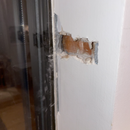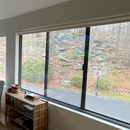Insulating new windows with drywall returns
I have a 1983 home with original aluminum metal gliding windows. Lots of windows and pretty big. We are looking to replace them with Marvin Essential series Casements. Our plan is to use new construction windows with nailing flanges. Removal and installing will be from the exterior. We made some small openings in the drywall around a few windows to see how the old ones are sized in relation to rough openings. For the most part, the old windows have a 1/4” gap from edge of window to edge the rough opening stud. My contractor is posing some options to us how we want to go about insulating/air sealing around the windows once they are installed: Since we have drywall returns, we can’t simply remove the casing to foam in the gap around window.
Option #1: is to remove the drywall returns and redo them after the gaps are sealed. We have over 20 windows so this seems messy and invasive.
Option #2: is undersize the windows to create a larger gap that extends beyond the edge of drywall. This would mean approximately 3/4” gap around perimeter which would then be filled with foam and then a small trim piece to cover the foamed area, without having to remove the existing drywall.
Option 3: Just install without foaming around them. Sealant and flashing tap on exterior only, with hope of blocking *most* air infiltration. Premise here is that the house is from ‘83 and by no means constructed tight. The sheathing and tyvek house wrap is not well sealed at all and the air infiltration into the wall cavity from new windows is probably negligible compared to the rest of the house’ construction.
Curious to hear opinions on best approach or if there’s an idea I’m not thinking of? What approach do people usually take in this scenario?
I’ve attached a photo of one of our windows and a photo of the drywall opened to show the rough opening.
GBA Detail Library
A collection of one thousand construction details organized by climate and house part











Replies
It's going to be messy, there's no way around it. The drywall returns will probably get damaged and need touching up anyways. If you're going to do it, you might as well go through with the whole process. Drywall is cheap and easy to repair, compared to the cost of the window installation, in my opinion.
You would also have to be careful that your window flanges would still be able to be fastened to the rough opening with an extra 3/4” gap.
I agree with Kyle, option 1.
kyle_r,
Good point. The flanges on the windows I use are 1 1/4" . Even with standard gaps catching the framing while nailing can sometimes be difficult.
PRhome,
Option 4: Cut back the drywall enough to leave a 1" gap to the inside of your new window frame. Insulate and seal, then case the windows with 2" trim.
Malcolm, that's about what I was going to recommend.
In case the idea of using a utility knife for that much cutting was making PRhome worried, I have found that a multi-tool and a shop vac work well for that kind of drywall cutting. If you're having trouble making a straight cut, you can follow a strip of wood. The cut doesn't have to be perfect but a reasonably straight line would make it easier to piece in strips of drywall instead of adding trim.
I have to ask about the plan to use new construction windows.
That seems next to impossible to removing the current windows, flashing and the siding over the flashing and putting it back correctly is a ton of work. The hardest part is blending the old and new work seamlessly.
If your contractor and make the outside look right the drywall will be a piece of cake so long as you are up for repainting the interior house or willing accept the returns being a different color than the walls.
Walta